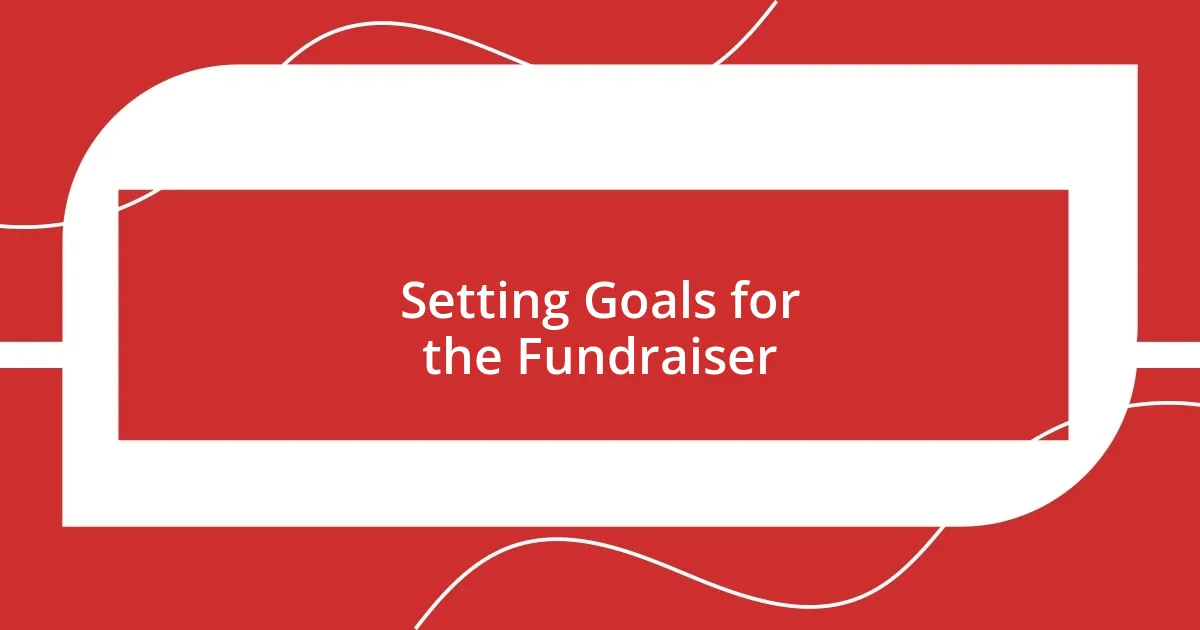Key takeaways:
- Choosing a fundraiser type should align with personal passions and community interests to foster engagement and connections.
- Setting clear, achievable goals—both financial and impact-oriented—helps track progress and motivates team involvement.
- Effective promotion through social media, local outreach, and emotional storytelling can significantly increase community support.
- Measuring success involves both quantitative metrics and qualitative feedback, highlighting the broader impact on the community.

Choosing a Charity Fundraiser Type
When it came to choosing the type of charity fundraiser, I found it essential to align it with my passions and those of my community. For instance, I remember organizing a bake sale because I’ve always loved baking, and it gave my friends a chance to share their favorite recipes too. It not only felt personal but also created a warm, inviting atmosphere that naturally drew people in.
I also learned that understanding your audience is crucial in this decision-making process. During one of my fundraising events, I had a moment of realization when I noticed how engaged everyone was during a trivia night. People were not just there to donate; they were excited to participate! Have you ever attended an event where you felt like part of something bigger? That’s the magic I wanted to recreate.
Ultimately, blending what I care about with the interests of those around me made all the difference. While planning a charity auction, I decided to add local art pieces to the items for sale because the arts community is vibrant here. It resonated with our audience so well, showing that the right type of fundraiser can spark connections and amplify support for the cause.

Setting Goals for the Fundraiser
Setting clear and achievable goals for your charity fundraiser is crucial. I remember when I first organized a fundraiser, I aimed for an ambitious target without fully understanding what it would take to get there. It was a wake-up call! Setting a balance between aspiration and realism not only provides direction but also helps track progress effectively. Have you ever set a goal that felt a bit out of reach? You learn quickly the importance of breaking it down into smaller, manageable steps.
Moreover, involving your team in the goal-setting process is invaluable. When I collaborated with my volunteers during our last event, we brainstormed together to establish not just financial targets but also involvement goals—like engaging a specific number of attendees. This shared vision fueled everyone’s motivation and made each member feel invested in the outcome. The sense of purpose that comes from collective commitment transforms the experience into something truly memorable.
Finally, focusing on impact alongside financial goals can reshape your approach. For example, during one fundraiser, I set a goal not just to raise $5,000 but also to secure 100 volunteer hours for the charity. By examining our broader objectives, we could communicate our mission more effectively. This dual approach cultivated a deeper emotional connection with our audience. After all, isn’t it amazing when fundraising becomes a shared journey towards meaningful community change?
| Type of Goal | Example |
|---|---|
| Financial Goals | Raise $5,000 |
| Engagement Goals | Reach 200 attendees |
| Impact Goals | Secure 100 volunteer hours |

Finding Sponsors and Donations
Finding sponsors and donations can be one of the most rewarding aspects of organizing a charity fundraiser. From my experience, I realized that tapping into personal networks can yield fantastic results. When I reached out to local businesses, I was surprised by how many were eager to contribute. It felt heartwarming to see their willingness to support the cause and how excited they were to become part of our community effort. It’s all about building relationships; the more genuine your approach, the more likely you are to find sponsors who resonate with your mission.
Here are some effective strategies for securing donations and sponsorships:
- Leverage Personal Connections: Start with friends, family, and colleagues who may have ties to local businesses.
- Craft a Compelling Pitch: Share your passion and explain how their support will make a difference. Personal stories can truly resonate.
- Offer Recognition Opportunities: Sponsors appreciate visibility. Consider promoting their businesses during the event through banners or social media shout-outs.
- Highlight Community Impact: Explain how their support not only helps the cause but benefits the community as a whole.
- Follow Up: Don’t underestimate the power of a thank-you note or a follow-up email. It fosters goodwill and may encourage them to support your future endeavors.
As I ventured further into the fundraising world, I learned that even small contributions can add up. I remember receiving an unexpected donation from a local artist who simply believed in our cause. It was a beautiful reminder that sometimes, passion speaks louder than a hefty check. Each donation came with its own story, making every contribution feel like a piece of the larger puzzle we were creating together.

Promoting the Fundraiser Effectively
Promoting your charity fundraiser effectively is all about leveraging multiple channels to reach your audience. I found that social media was a game changer for me. The instant reach and ability to share updates created a buzz that I hadn’t anticipated. Have you ever noticed how a simple post can spark conversations? It’s thrilling to see community members rally around a cause, sharing information and encouraging others to join in.
Beyond social media, I also utilized local community boards and news outlets. During my last fundraiser, I pitched the event to a local radio station, and they aired an interview with me. That small opportunity turned into a wave of interest from the community, and people came out to support us more than I imagined. Engaging with the media not only broadened our exposure but also added credibility to our mission. When you put yourself out there, it’s amazing how many people want to be involved!
Additionally, I learned the value of creating visual content. High-quality flyers and videos helped to tell our story in a way that words alone sometimes can’t. I remember crafting a heartfelt video that showcased not just the goals of the fundraiser but also the faces of those we were helping. Seeing that emotional connection sparked even more engagement than I expected. In my experience, when promotional materials resonate on a personal level, they turn passive observers into passionate supporters.

Executing the Fundraiser Day
As the big day approached, I felt a mix of excitement and nerves. On the morning of the fundraiser, I arrived early to set up and double-check everything. With each banner I hung and table I arranged, my anticipation grew. Have you ever felt that palpable energy before a big event? It’s a feeling like no other, knowing that you’ve put so much effort into bringing people together for a cause you care about.
During the event, I was amazed by the community’s response. One moment that stands out for me was when a local youth group performed a dance to raise additional funds. The joy on their faces as they engaged with the audience was infectious, and it reminded me that this day wasn’t just about raising money—it was about building connections and celebrating our togetherness. Witnessing everyone come together, united for the same purpose, truly touched my heart.
As the fundraiser wrapped up, I made it a point to personally thank everyone involved. I found that expressing gratitude not only deepened our connections but also encouraged everyone to stay engaged with the cause moving forward. I still remember the smiles and the warmth in people’s responses. Isn’t it incredible how a simple “thank you” can leave a lasting impression? It’s moments like these that reaffirm my belief in the power of community and shared purpose.

Measuring Success and Impact
To truly measure the success and impact of your charity fundraiser, I believe it’s essential to analyze both quantitative and qualitative data. After my last fundraiser, I tracked the total funds raised compared to my initial goal. I was thrilled to see we surpassed our target by 30%. But more than the numbers, I reflected on the personal stories that came from our community, like the single mother who said our initiative changed her family’s life. How do we quantify the joy and hope we bring? That’s where qualitative feedback plays a vital role.
Moreover, I actively sought out feedback from participants through surveys and informal conversations. One poignant moment happened when a volunteer shared how the experience inspired them to create a support group for those in need in our area. It reminded me how a single event can ripple through lives in unexpected ways. Have you ever thought about the long-term impact of your efforts? I realized that measuring success transcends monetary gains; it’s about the relationships we build and the community spirit we foster.
Finally, I kept track of our engagement metrics post-fundraiser. Watching the increase in followers on our social media channels and receiving messages from people wanting to know how to get involved in future initiatives was a huge indicator of our event’s impact. It’s like planting seeds of change—sometimes you can see them sprout right away, while other times it takes a little longer. Isn’t it rewarding to see that the energy from one event can fuel ongoing conversations and inspire future actions? This reflection has taught me that success is multi-faceted and often more profound than the numbers alone.















